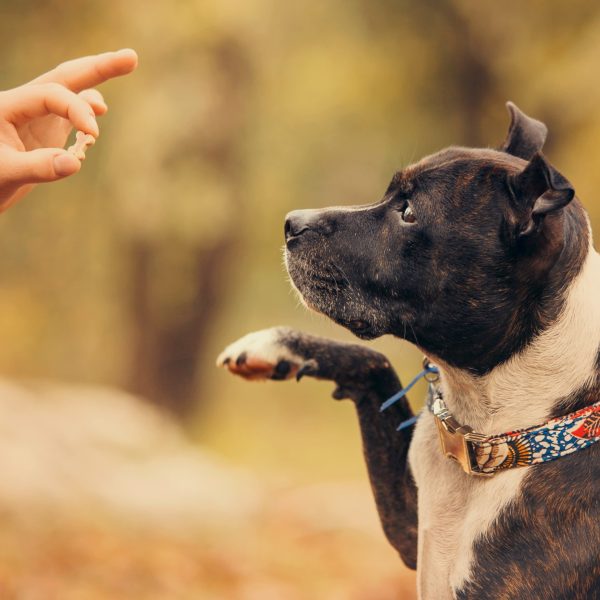5 Different Types of Dog Training Methods

When bringing a new dog home, it might be overwhelming to think about training. There are a few different types of training methods to try, but which one is right for you and your dog? Here are just a few of the different types of dog training methods:
1. Positive Reinforcement
In positive reinforcement training, the trainer rewards the dog for good behavior. Sometimes trainers use treats or kibble to reward pups. Trainers will then ignore bad behavior or withhold treats when a dog doesn’t behave well.
Owners often use a “clicker” device* to signal instantly when a dog has done something good *(Amazon Affiliate Link). When the dog hears the clicker, they know that a treat will follow. Clickers can also be useful in getting your dog to pay attention to you in order to be able to listen to the command.
Positive reinforcement is a good method for teaching tricks. It can also work for general behavioral training, like helping your dog get over their fear of stairs. But, it may not be as helpful in adjusting or redirecting an already-formed behavior or habit. For example, if your dog is in the habit of chasing the mail carrier, positive-only training may not help as much as another method to improve your dog’s recall training or redirect the behavior.
2. Respect-Based Training
This is an alternative to the popular positive-only training. It allows trainers to both reward their dogs and effectively teach them to avoid bad behavior. The dog learns to respect their owner because there are both positive and negative consequences.
A trainer can signal that a behavior is good in a number of ways. For example, treats, extra playtime, extra petting, and positive verbal cues are all rewards for behavior. Some trainers can even display a positive facial expression and it’s effective. There’s also the clicker, which is useful for respect-based training as well as positive reinforcement.
Negative consequences can also be a variety of things. Don’t worry, they’re nothing to be afraid of. They can include cues using facial expressions, voice, body language, hand gestures, or gentle leash cues. You never need to use violence to get a dog to respect you.
In the end, this respect-based training method may be less confusing to your dog than positive-only training because they get a clear consequence for every behavior.
3. Model-Rival Training
Model-rival training, or mirror training, is a method where the dog is expected to follow the example of a human who is being “trained” by someone or another dog who has already mastered the command or behavior.
The model and the dog may compete for resources, such as treats. Whoever follows the trainer’s command gets to eat the treat. This sense of competition encourages the dog to learn more quickly.
4. Relationship-Based Training
This type of training acknowledges that your dog has emotions or feelings and keeps that in mind during training. The goal is to keep your dog feeling stress-free during training. It sets out to teach you how to get to know your dog as an individual and use that in training.
Train in a distraction-free zone and teach very basic commands every dog should know. Once your dog masters those, you can begin trying harder commands. If they struggle, look at the environment to determine what might be holding them back from succeeding.
The goal is to help your dog feel secure so they can learn effectively. It uses your relationship with your dog to motivate them to pay attention and learn. You and your attention are a reward to your dog, along with treats and toys. This aspect is where relationship-based training can overlap with positive-reinforcement training.
5. Science-Based Training
This training takes an in-depth understanding of dogs, their behavior, nature, ability to be conditioned, and how well rewards and punishments work. Animal behaviorists and scientists are continually hypothesizing and running tests to help us understand animal psychology. However, because science is always changing and updating, it can be hard to define an overarching method.
For most behaviorists, there is a theme of relying on positive reinforcement and some punishments. Others believe that it’s more important to learn how to strengthen good behavior without needing rewards. They also study how to develop stronger off-leash relationships between owners and their dogs.
Since there’s a lot of research and science involved in this method, it’s probably best to leave this method to professional dog trainers. However, as an owner, it is important to stay informed on new findings and see if it is a good fit for your dog.
These are just a few different types of dog training methods. Several of the best YouTube channels for dog lovers have tips and tricks to help you with training. If you feel overwhelmed with choosing one, talk to your vet or contact a dog trainer. They’ll be able to walk you through your options and pick the best one for you and your pup!
*Greenfield Puppies is a participant in the Amazon Services LLC Associates Program, an affiliate advertising program designed to provide a means for sites to earn advertising fees by advertising and linking to amazon.com. Greenfield Puppies may earn a commission for purchases made through Amazon affiliate links on our site.
